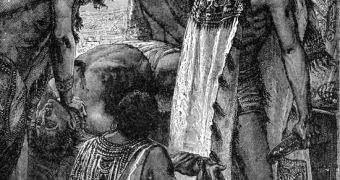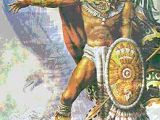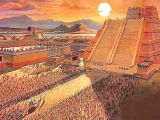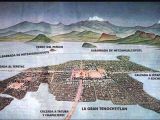"The enormous market swarmed of people; some buying, some selling...Amongst us were soldiers which had traveled in many parts of the world, from Constantinople to Italy and Rome, yet they said they had never seen a market of such proportions so harmonious and balanced, harboring so much people", wrote Bernal Diaz del Castillo, a soldier from the army of the Spanish conquistador Hernan Cortes, about Tenochtitlan, the Aztec capital, when he visited it in 1519.
By those times, the city had 150,000 to 200,000 inhabitants and a surface of 12 to 15 square kilometers, with many bridges, streets, channels, and shiny temples with the shape of truncated pyramids. But our image about their complex civilization is shadowed by the bloody side of their religion. Its sure that their gods required human hearts and blood to maintain their strength and Aztecs are more known for their bloody rituals of ripping the hearts while still alive from the chests of sacrificing victims in the honor of their gods
In the history of the Mesoamerican civilizations, the Aztec one occupied a very short period of time. The oldest complex civilization in the area is that of the Olmecs, which lasted from 1,200 BC to 400 BC. This civilization invented many of the cultural and religious characteristics of the later civilizations, like writing, calendar and truncated pyramid shaped temples. The longest lived of these civilizations was Maya (1,000 BC-1,500 AD), and later emerged the Zapotecs (500 BC-1,000 AD), Teotihuacan (0-700 AD), and Toltecs (900-1,200 AD).
The Aztecs lately, around 1,200 AD, and their civilization lasted just 300 years, while their empire dominated just 100 years the area before failing under the sword of the conquistadors. Still, at its peak the empire spread till Guatemala, and was one of the most advanced civilizations of America, with cities as larger as those of contemporaneous Europe.
The name Aztec comes from "Aztlan" "white land". But where Aztland was nobody knows. Still, it seems to have been located somewhere in the southwestern US, as the Nahuatl, the language spoken by the Aztecs, belongs to the Uto-Aztec groups of languages, spoken by more familiar tribes in the American history like Paiute, Shoshoni, Comanche, or Hopi. Some elements of Hopi culture can be recognized in the Aztec ones, like the adobe huts.
The legend says that Aztecs were the last of seven groups leaving that land at the order of god Huitzlopochtli, the Sun and War God, depicted as a feathered snake, starting a long journey in the search of a motherland. The tribe migrated for decades, enduring shortages and sufferings in a continuously war with the neighboring people, in the search of the sign: an eagle over a cactus. This was observed finally in 1325 AD on a small island on the Texcoco Lake a bald eagle over a rock devouring a snake. The snake was the symbol of the main Toltec god, and Toltecs had harassed for years the Aztecs. The migrants established there and built the city later named the Great Tenochtitlan ("The stone raising from the water"). Some say the name comes from that of a legendary patriarch called Tenoch. Today, Tenochtitlan is located under Ciudad de Mexico. The eagle devouring the snake turned into the symbol of Tenochtitlan and today of Mexico.
Proving to be skilled engineers and dabs, the Aztecs employed the bottom of the lake as a foundation and extended the city by building embankments. Roads built on dikes established the connection with the mainland and many channels were realized.
By that time Aztecs were not known under this name, but Mexica. In time, the surrounding land and inhabitants got this name. But Mexicas were not the first inhabitants of the area, and they had to establish alliances with neighboring tribes. Those opposing them were crushed. The Aztec gods and goddesses regularly required bloody hearts and human sacrifices, and the war prisoners turned into the main victims of these sacrifices. The Aztecs' reputation of using this way the war prisoners spread dread into their opponents.
The most valuable warriors, distinguished through their braveries, were allowed to enter the military orders of the Jaguars or Eagles, which came with many honors and privileges, like receiving land and slaves, and were free of paying fees. The Jaguar knights, covered in jaguar skins, reunited for secret dances and rites to increase their already recognized power. They also had the mission of guarding the temple of the most powerful Aztec god, Tezcatlipoca ("the smoking mirror"), creator of the Universe, and permanently young, but also god of the darkness and the night, and master of the wizards practicing black magic, to which they offered horrible human sacrifices.
Aztec education consisted almost exclusively in military instruction, as the war maintained the economic prosperity based on the tributes paid by the dominated people. All physically apt men fought. The tough wars were carried on with slings, spears, and bludgeons, but the main weapons remained the bow with arrows and a type of plan wooden sword with obsidian blades embedded on it; for defense the Aztecs employed shields made on woven canes, covered by cotton and decorated by feathers and also animal head-shaped helmets. The great lords wore cuirasses made of gold plates and over a feathered cloak; sometimes they dressed like gods, wearing enormous feather dressing.
The Aztec religion was a mix, but they fundamentally worshiped gods related to agriculture, to which they dedicated rites and sacrifices meant to bring rain and fertility to the fields; many of these gods were taken from the surrounding people. The dominant gods were Huitzlopochtli, Tlaloc (the Rain God) and the terrible Coatlicue (the Goddess of the Death). The priests accumulated so much power that sometimes they dominated the emperor. Tlaltecuhtli, goddess of earth, was represented as a huge-clawed woman, with a stream of blood flowing into her mouth as she squats to give birth. In Aztec beliefs, this goddess devoured the dead and then gave them new life.
Aztecs also had diviners, specialized in astrology. The stars, their movement, and time counting were extremely important. The Aztec calendar was one of the most astonishing achievements of their culture. Sculptors made many representations of them, the most famous being "The Sun Calendar", a gigantic stone disc covered by reliefs and hieroglyphs of the days.
The Aztec empire extended outside Tenochtitlan to vast areas of Central America, stretching from the Gulf of Mexico to the Pacific Ocean and encompassing much of modern-day central Mexico. The Aztec culture assimilated new ideas and religious habits. The conquered people had to send heavy tributes to the Aztecs, and during this period music, literature and art flourished. The Aztec sculptures were amongst the most precious along history. Aztecs covered their temples with reliefs and sculptures representing their gods with dreadful faces. They were also extremely skilled in making mosaics from fine stones: jadeite, turcois, malachite, cornelian, and others. The mosaics adorned masks, jewels or the handle of sacrifice knives. The sacrifice knives had an obsidian blade and a handle richly adorned with human and animal shapes, wrapped in the mosaic. The blade was connected to the handle through a gold string.
The Spaniards were amazed by the richly furnished and decorated palaces, stone paved streets, irrigated fields, rich fabrics, feathered wraps, magnificent gold, silver and precious stone jewels. The Aztecs did not know writing, but they used pictographic symbols, representing objects through drawings, number through symbols, and names through hieroglyphs (for example, the name of the king Itzcoatl through a snake "coatl" and knife "itzli"). They wrote with feather brushes over parchments made of deer skin and agave paper.
Dance for the Aztecs had just a religious meaning. It consisted in rhythmic movements of the arms and thighs, being executed by several persons on the accord of sounds emitted by cane flutes, wood, bone or ceramic pipes, sophisticated whistles, sea snails, drums, bells, rattles. The dances depicted myths and legends of the gods, represented by the best dancers, in rich cloths, with feathered fans and enormous circular cloaks representing the Sun. The feathers used for the dressings came from hummingbirds, parrots, toucans, manakins and other tropical birds. The feathers' colors were combined in beautiful mosaic patterns, the feathers being inserted in a previously made web.
The village people lived in rectangular adobe huts with a plan roof made of agave leaves. Rich people lived in palaces with an inner yard, with stone walls covered by stucco, with wooden furnishes, and rich fabrics on the walls.
The most outstanding buildings in the Aztec cities were the large truncated pyramid shaped temples, with a small sanctuary on the top, o which the climb was made through ample steps. Each temple was dedicated to a god. On the sanctuaries, the priests, covered by tall feathered dressings, realized the terrible human sacrifices.
The main crops of the Aztecs was the corn, cultivated in well cared fields, irrigated through a perfect channel system, and protected by adobe or agave fences. The corns was preserved in silos and the famous Mexican tortilla, made of corn flour, has an Aztec origin. Aztecs also cultivated squash, beans, cacao, vanilla, tobacco, cotton, avocado, guava, pineapple, and agave. The agave was used this way: spines for needles, the trunk in constructions, the comestible roots were eaten and the leaves were turned into fibers for making paper.
The diet was completed with fish (captured with webs and by harpoon) while meat was a luxury item to which mainly rich people had access. Frogs were eaten. Aztecs grew only two domestic species: dog and turkey. Special dog races were bred for meat. Deer, peccaries (a type of wild bore), rabbits and wild birds (quails, doves, geese and ducks) were hunted. The hunt was made with spear propellers, the bow and arrows, stone clubs, slings and for rabbits also the boomerang. Big game was reserved for nobles. Aztecs also consumed the aquatic larvae of a fly, which they turned into a comestible paste still eaten today in Mexico.
Aztecs were very similar physically to other Indigenous people of Mexico: on average 1.65 m tall, darker coppery skinned, with strong brachycephaly, outstanding cheeks, thick lips, large noses (but not aquiline), and black straight haired. Women wore loose long hair and adorned themselves with earrings, collars, nose and lip piercings, broaches and belts, made of gold or silver, and embedded with precious stones. The jewelry, fabrics, and feathered cloaks marked social differences, and were taboo to be worn by low rank people. Aztecs women wove the cotton fabrics.
When the Spanish arrived, in November 1519, Aztecs were at the peak of their glory. The ninth Mexica emperor, Moctezuma II, received peacefully the 450 conquistadors of Cortes, believing that Cortes was the reincarnation of the Aztec god Quetzalcoatl. But besides deeply religious and superstitious, the Aztecs were also na?ve and allowed the Spanish see their gold treasures. Cortes planned to take all their gold, and in a bravery act, Spaniards took Moctezuma prisoner in his own city. Some say Moctezuma agreed and did not oppose resistance. But Cortes had to head urgently to the coast, and left behind an impulsive man as leader, Pedro de Alvarado. Fearing that in the lack of Cortes the Aztecs could raise against him, Alvarado massacred a lot of Aztecs during a festivity. Cortes found the city in a deep chaos when he returned. During the following battle, Moctezuma died, probably killed by Spaniards. Other sources say that Cortes convinced Moctezuma to present himself to his people and ask them to cease the fight, but he was stoned to death by the Aztecs. Anyhow, Cortes with a few wounded survivors managed to escape.
The Spaniards reorganized, and this time they were accompanied by local tribes, hating the Aztecs and eager to get rid of the Aztec yoke. During the subsequent bloody siege, it is said that the Aztecs sacrificed the captured Spanish soldiers, and this enraged the Spaniards, increasingly decided to win. The former vassal tribes revenged with cruelty all they had suffered from the Mexicas in the past, looting them of all possessions.
On 13 August 1521, the Great Tenochtitlan failed, and the last great indigenous civilization vanished. Spaniards not only changed the zone's politics, but also brought with them a new religion which often was imposed to the Aztecs. The result was a religious syncretism, in which the goddess Tonantzin worshiped on the Tepeyac Hill was replaced by the Holly Virgin of Guadelupa, the Church of Guadelupa being built exactly over the same place where the goddess was venerated. Today, during the Christian religious festivities hold in the honor of the Virgin, the prayers roll and dance in the rhythm of the pagan ancestral dances, right in front of the church.
Today, most of the Mexican population is metis, resulted from the cross of the Spanish people with the locals. Today, over 5 million people in Mexico still speak Indigenous languages, and over half of them Nahuatl, of Aztec origin. Most of the modern Aztecs are farmers, living in isolated areas, which prevented development, but also preserved their language and traditions.
Which is the international legacy of the Aztecs? Beyond the rich Mexican cuisine, there are some words in English and many other languages rooted in Nahuatl: avocado ("aguacatl" "testicle", from the fruit's shape), chocolate ("chocolatl"), cacao, tomato ("tomatl"), copal, ocelot ("ocelotl"). And not to forget, the domestic turkey!

 14 DAY TRIAL //
14 DAY TRIAL // 



